10 owl species found in South Carolina:
- Eastern Screech Owl – Smallest owl in SC, found in wooded areas.
- Barred Owl – Common, active during dawn/dusk, found in forests near swamps.
- Barn Owl – Recognizable by its heart-shaped face, often found in open areas.
- Great Horned Owl – Large, powerful predator found in diverse habitats.
- Short-eared Owl – A winter visitor, often seen in grasslands and marshes.
- Snowy Owl – Rare winter visitor, typically found in open fields.
- Long-eared Owl – Rare winter visitor, prefers dense forests near open areas.
- Northern Saw-whet Owl – Small, elusive, mostly found in forests.
- Burrowing Owl – Occasionally spotted, prefers open habitats.
- Great Gray Owl – Rare vagrant, typically found in northern regions.
Owls of South Carolina: Details
South Carolina is home to many fascinating owl species, each with unique traits and behaviors. These owls are known for being great hunters with sharp talons, excellent night vision, and the ability to fly silently. From the Great Horned Owl, a strong and powerful predator, to the tiny Eastern Screech Owl, which can live in forests or backyards, these birds play an important role in keeping the balance of nature. South Carolina’s forests, grasslands, and wetlands provide perfect places for owls to hunt and nest, offering birdwatchers a chance to spot these amazing creatures in the wild.
Eastern Screech Owl: The Small but Mighty Forest Dweller
- Wingspan: 48 – 61 cm
- Length: 16 – 25 cm
- Mass: 121 – 244 grams
- Maximum Lifespan: 14 years
- Scientific Name: Megascops asio
- Color Morphs: Grey or Rufous
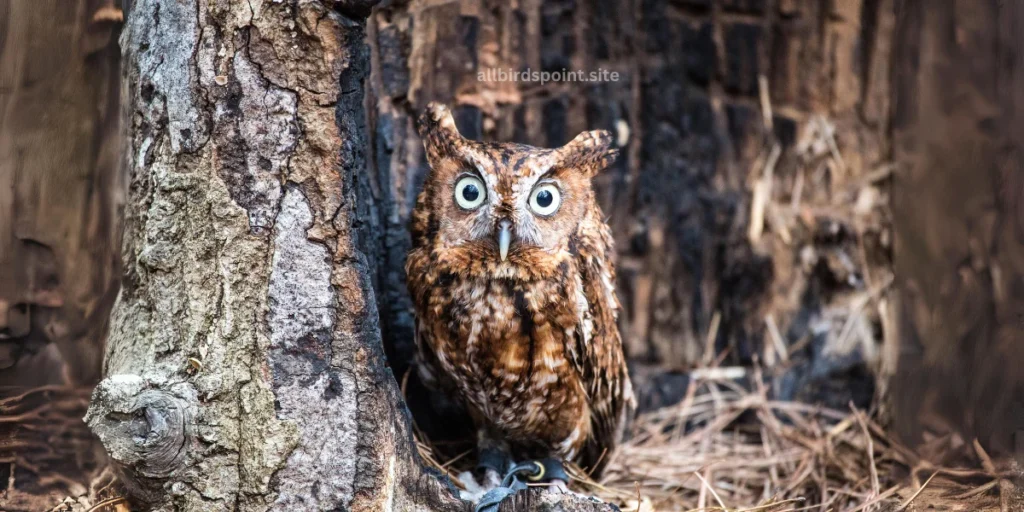
Appearance of the Eastern Screech Owl
The Eastern Screech Owl is one of the smallest owls in South Carolina. It has two color forms: grey and rufous. The grey morph looks like tree bark, helping the owl blend into its surroundings, while the rufous morph is reddish-brown, perfect for blending in with autumn leaves. Both types have yellow eyes and short ear tufts, making them look like they have tiny horns on their heads.
Habitat and Nesting
Eastern Screech Owls are adaptable and can live in many places. They are found in forests, parks, and even backyards. They prefer to live in holes in trees, but they are also happy to nest in nest boxes provided by humans. Sometimes, they even use old mailboxes as their homes! These owls don’t build nests from scratch; instead, they use holes made by other animals, like woodpeckers.
Hunting and Diet
Though small, the Eastern Screech Owl is an expert hunter. It hunts mainly at night, flying silently to catch its prey. This owl eats a variety of things, including mice, small birds, worms, and insects. They even hunt lizards and frogs when they can find them. Their diet changes based on what is available, which is why they thrive in so many different environments.
Best Places to Spot Eastern Screech Owls in South Carolina
If you want to see an Eastern Screech Owl in the wild, head to Congaree National Park or Francis Marion National Forest. These owls love areas with lots of trees, but they can also be found in suburban parks and backyards. They’re more active at night, so evening is the best time to spot one.
Behavior and Calls
Eastern Screech Owls are known for their unusual calls. Instead of the traditional “hoot” sound, they make a whinny-like trill. The sound starts soft and gets louder, almost like a quiet whistle. This is how they communicate with each other, especially during mating season.
Barred Owl: The Owl with the Famous Call
- Wingspan: 99 – 110 cm
- Length: 43 – 50 cm
- Mass: 470 – 1050 grams
- Maximum Lifespan: 27 years
- Scientific Name: Strix varia
- Coloration: Mottled brown back, buff belly with vertical streaks
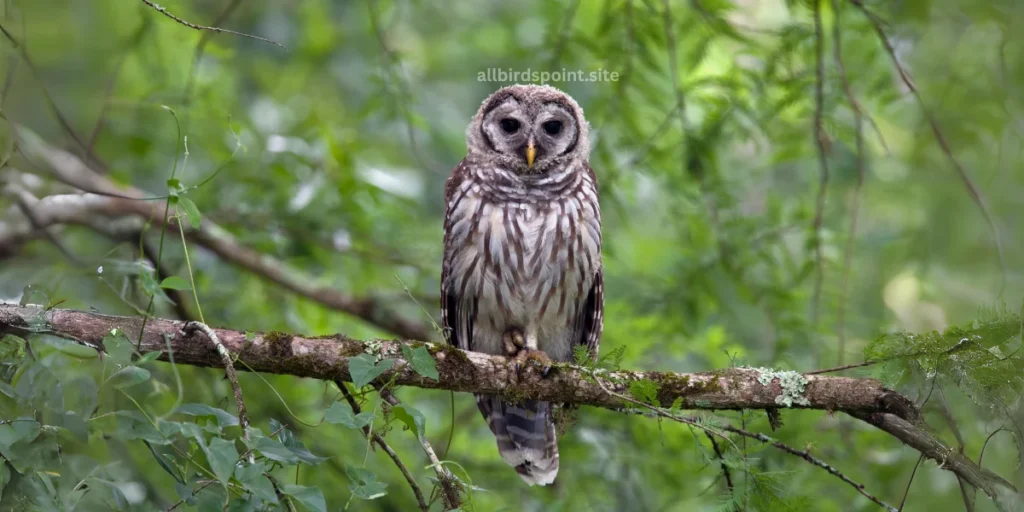
Appearance of the Barred Owl
The Barred Owl is a large, round-headed owl with no ear tufts. It is easily recognized by its mottled brown and white feathers. The chest is horizontally barred, giving it the name “Barred Owl,” and the belly features vertical streaks. It has a distinctive yellow beak and dark brown eyes, which set it apart from many other owl species with yellow eyes.
Habitat and Nesting
Barred Owls are most commonly found in old forests, particularly near swamps, streams, and other bodies of water. These owls like to nest in tree cavities or old stick nests made by other animals. Sometimes, they may use nest boxes placed by humans. They typically lay 2 to 4 eggs, which are incubated for around 28 to 33 days. The owls are not known for moving long distances, often staying within a 6-mile range of where they were born.
Hunting and Diet
Barred Owls are nocturnal but are sometimes active during the day, particularly around dawn and dusk. They are opportunistic feeders, meaning they will eat whatever they can catch. Their diet includes small mammals like mice, squirrels, and rabbits, but they also eat birds, reptiles, frogs, and insects. Barred Owls hunt by swooping down silently from a perch to catch their prey with their sharp talons.
Best Places to Spot Barred Owls in South Carolina
In South Carolina, Barred Owls can be found in places like Sumter National Forest, Francis Marion National Forest, and Congaree National Park. These owls prefer wooded areas with nearby water sources, which makes these parks ideal habitats. They are often more visible during the early morning or late evening hours.
Behavior and Calls
One of the most famous things about the Barred Owl is its unique call, which sounds like “Who cooks for you? Who cooks for you all?” This call is often heard in forests and swamps, especially during the breeding season. These owls are known for being highly territorial and will often hoot to communicate with other owls and defend their territory.
Barn Owl: The Ghostly Hunter of Open Fields
- Wingspan: 100 – 125 cm
- Length: 32 – 40 cm
- Mass: 400 – 700 grams
- Maximum Lifespan: 15 years
- Scientific Name: Tyto alba
- Coloration: Pale face with white underside and cinnamon-colored back
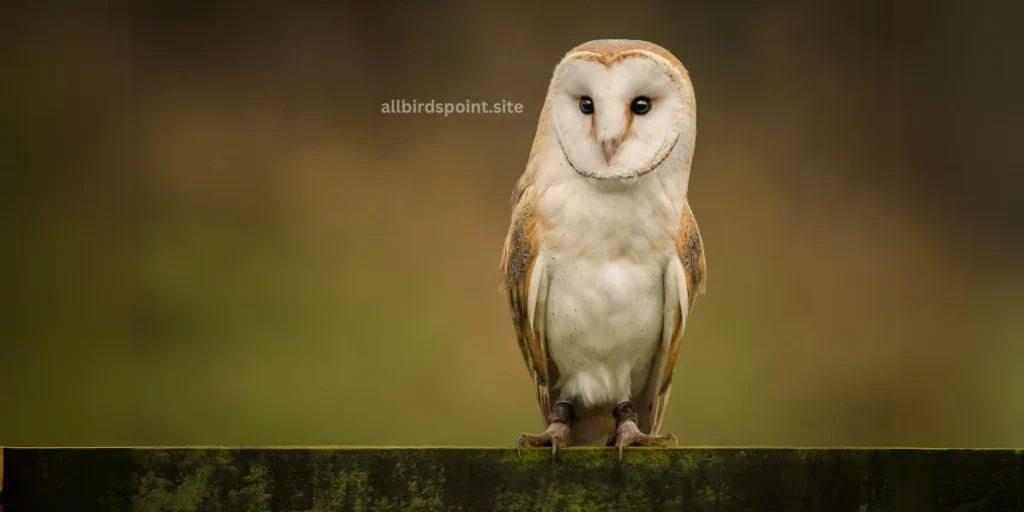
Appearance of the Barn Owl
The Barn Owl is easily recognized by its heart-shaped face, which is white and contrasts with its cinnamon and grey-colored back. Its pale face and underbelly make it stand out among other owl species. The Barn Owl’s large dark eyes give it an ethereal appearance, and unlike many owls with hooting calls, the Barn Owl is known for its distinct raspy screech.
Habitat and Nesting
Barn Owls are highly adaptable and can be found in a wide range of habitats. They prefer open fields, grasslands, and farmlands, but they are also commonly seen in suburban and even urban areas. Barn Owls often nest in barns, abandoned buildings, and tree cavities. They do not build traditional nests but use regurgitated pellets to create a soft bedding for their eggs. The female lays between 2 to 18 eggs per brood, and the incubation period lasts 29 to 34 days.
Hunting and Diet
Barn Owls are nocturnal hunters and are incredibly skilled at hunting in complete darkness. They primarily feed on small mammals like mice, voles, shrews, and sometimes small birds. Their hunting technique is remarkable: they rely on their acute sense of hearing to locate prey, often using the slight rustle of movement to swoop in silently and catch their meal. This makes them highly effective predators, especially in open areas.
Best Places to Spot Barn Owls in South Carolina
In South Carolina, Barn Owls can be seen in open farmland and areas with abandoned structures where they can nest. Specific locations such as the Francis Marion National Forest and Congaree National Park are good spots for spotting Barn Owls. They are more often seen at dusk or during the night when they are hunting.
Behavior and Calls
Unlike other owls that “hoot,” the Barn Owl is known for its eerie, raspy screech, which is quite loud and can be startling if heard at night. These calls are most often heard during the breeding season when Barn Owls communicate with potential mates. Despite their haunting call, Barn Owls are shy and elusive, preferring to avoid human interaction as much as possible.
Great Horned Owl: The Fearless Predator of the Night
- Wingspan: 101 – 145 cm
- Length: 46 – 63 cm
- Mass: 910 – 2500 grams
- Maximum Lifespan: 28 years
- Scientific Name: Bubo virginianus
- Coloration: Grayish-brown with mottled pattern, reddish-brown face, and white throat patch
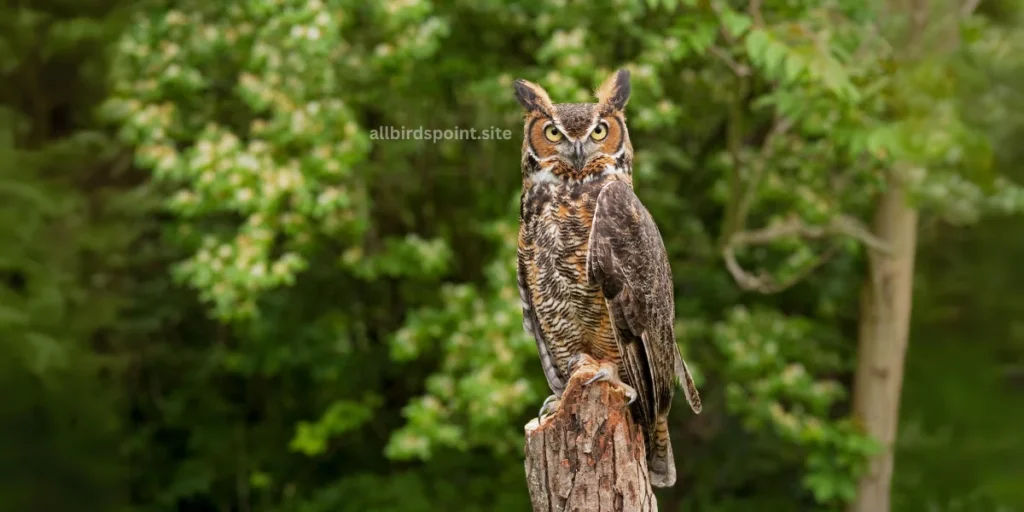
Appearance of the Great Horned Owl
The Great Horned Owl is the largest owl species found in South Carolina and one of the most powerful predators. It has a distinctive appearance with its large ear tufts that resemble horns (hence the name), yellow eyes, and a reddish-brown face. Its feathers are a mix of brown and grey, with a white patch on its throat, and its body is covered in a mottled pattern. This owl’s strong talons and sharp beak make it a formidable hunter.
Habitat and Nesting
Great Horned Owls are highly adaptable and can live in many different habitats, including forests, wetlands, grasslands, deserts, and even urban environments. They nest in a variety of places, such as tree cavities, cliff ledges, abandoned buildings, or even old nests built by other large birds, like hawks or crows. The female typically lays 1 to 4 eggs, and the incubation period lasts 30 to 37 days.
Hunting and Diet
The Great Horned Owl is an apex predator, meaning it’s at the top of the food chain. It has a diverse diet, feeding on mammals like rabbits, squirrels, mice, and even skunks. It can also take down other birds, including large species like ducks and even other raptors, such as hawks or ospreys. Their strong talons can exert enough pressure to kill prey larger than themselves, making them fearsome hunters.
Best Places to Spot Great Horned Owls in South Carolina
In South Carolina, Great Horned Owls can be found throughout the state due to their adaptability. One of the best spots to observe them is the Santee National Wildlife Refuge, which provides ideal hunting and nesting areas. They are more likely to be seen during the evening or early morning when they are most active.
Behavior and Calls
The Great Horned Owl is well-known for its deep, resonant hooting call, which is often described as sounding like “Whoo, whoo-hoo, whoo”. These calls are most commonly heard during the night and are used for communication and marking territory. This species is fiercely territorial and will defend its nest aggressively if threatened, even against larger animals.
Short-eared Owl: The Daytime Hunter of Grasslands
- Wingspan: 85 – 103 cm
- Length: 34 – 43 cm
- Mass: 206 – 475 grams
- Maximum Lifespan: 12 years
- Scientific Name: Asio flammeus
- Coloration: Light brown with dark streaks, pale face with dark patches around the eyes
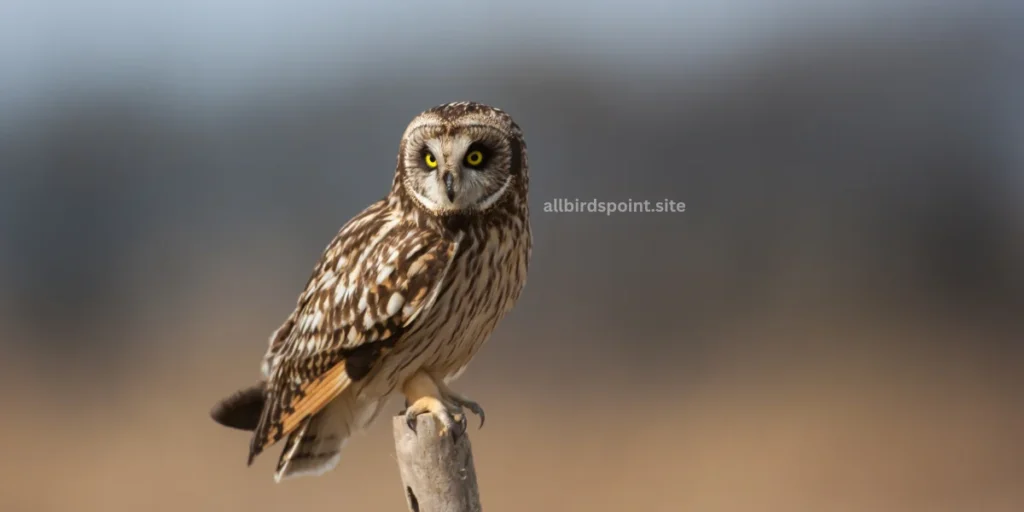
Appearance of the Short-eared Owl
The Short-eared Owl is a medium-sized owl with a rounded head and small, barely visible ear tufts, which are much shorter compared to other owls. Its body is covered in light brown feathers with dark streaks, making it blend in with grasslands. The owl’s pale face has distinctive dark patches around its eyes, giving it a striking look. Its wings are broad, making it an agile flyer, especially in open areas.
Habitat and Nesting
Unlike many owls that prefer forests, the Short-eared Owl is often found in open areas like grasslands, marshes, and meadows. In South Carolina, they are mostly seen during the winter as migratory visitors. They nest directly on the ground, usually in tall grass or other concealed areas. The female lays between 3 to 11 eggs, and the incubation period lasts about 24 to 28 days.
Hunting and Diet
The Short-eared Owl is unique among owls for its tendency to hunt during the day, particularly around dawn and dusk. It flies low over open fields, searching for prey with its sharp eyesight and hearing. Its diet mainly consists of small mammals, especially mice, voles, and shrews, though it also hunts small birds and insects. Their flight pattern is buoyant and moth-like, making them fascinating to watch as they hunt over grasslands.
Best Places to Spot Short-eared Owls in South Carolina
While not as common as other owls, the Short-eared Owl can be seen in South Carolina during the winter months. Some of the best places to spot them include Congaree National Park, Savannah National Wildlife Refuge, and Francis Marion National Forest. These owls prefer wide-open spaces where they can easily hunt their prey.
Behavior and Calls
Unlike many owls that are strictly nocturnal, the Short-eared Owl is often active during the day. It is generally quiet but can produce a soft series of hoots during courtship. The Short-eared Owl is also known for its dramatic flight displays during the breeding season, often involving sudden dives and loops to attract a mate.
Snowy Owl: The Majestic Visitor from the Arctic
- Wingspan: 126 – 145 cm
- Length: 52 – 71 cm
- Mass: 1600 – 2950 grams
- Maximum Lifespan: 24 years
- Scientific Name: Bubo scandiacus
- Coloration: Predominantly white with black or brown markings, yellow eyes

Appearance of the Snowy Owl
The Snowy Owl is one of the most striking owls due to its predominantly white feathers. Males tend to be almost entirely white, while females and younger owls usually have black or brown markings. Their large yellow eyes and lack of ear tufts set them apart from other owl species. The Snowy Owl’s pale color helps them blend into their snowy surroundings, making them highly camouflaged in their natural Arctic habitat.
Habitat and Nesting
Snowy Owls are native to the Arctic tundra, but in winter, they occasionally migrate south into the United States, including South Carolina. These birds prefer open landscapes like coastal areas, fields, and dunes where they can easily spot prey. Unlike most owls, they are often active during the day (diurnal), especially when winter days are short.
Snowy Owls do not breed in South Carolina, as they return to the Arctic for nesting. In their breeding grounds, they create nests on the ground, often on elevated spots to keep an eye on their surroundings. The female lays 3 to 11 eggs, with an incubation period of 32 to 34 days.
Hunting and Diet
Snowy Owls are powerful hunters with excellent vision and hearing. In the Arctic, they primarily feed on lemmings and other small mammals, but during their southern migrations, they hunt a variety of prey, including mice, rabbits, ducks, and other small birds. Their hunting style is similar to other owls: they perch and scan for movement before swooping down to catch their prey with their sharp talons.
Best Places to Spot Snowy Owls in South Carolina
Though rare, Snowy Owls sometimes appear in South Carolina during the winter months, particularly in open fields or coastal areas. The ACE Basin National Wildlife Refuge and Francis Marion National Forest are good places to look for these majestic owls. However, sightings are infrequent and often depend on food availability and weather conditions farther north.
Behavior and Calls
Snowy Owls are typically quiet outside of the breeding season, but when they do vocalize, their calls consist of deep, hooting sounds. They are highly territorial and may defend their feeding or nesting areas aggressively, particularly in their Arctic breeding grounds. Their ability to hunt both day and night makes them adaptable to various conditions during migration.
Long-eared Owl: The Elusive Owl of the Woods
- Wingspan: 90 – 100 cm
- Length: 35 – 40 cm
- Mass: 220 – 435 grams
- Maximum Lifespan: 27 years
- Scientific Name: Asio otus
- Coloration: Brownish-gray body with streaked underparts and long ear tufts
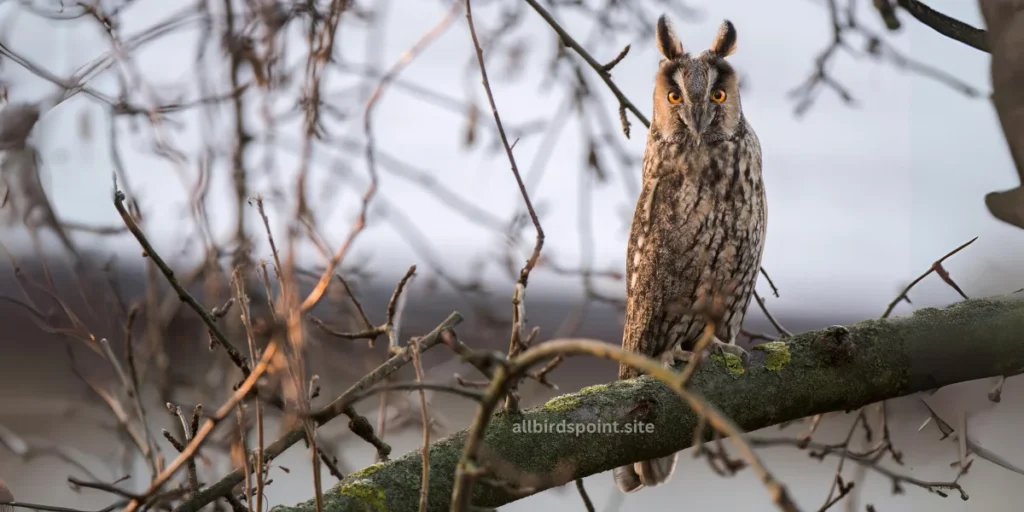
Appearance of the Long-eared Owl
The Long-eared Owl is known for its tall, prominent ear tufts, which give it a unique, expressive look. Its body is a mixture of brown and gray, with streaked whitish underparts that help it blend into the tree bark where it roosts. The owl’s face is a light orange color with striking yellow eyes, and its compact body allows it to remain hidden during the day, making it difficult to spot.
Habitat and Nesting
Long-eared Owls prefer dense forests or wooded areas that are located near open spaces such as grasslands or shrublands, where they hunt. These owls are highly secretive and rely on camouflage for protection. Unlike other owls that nest in cavities, Long-eared Owls typically take over abandoned nests built by other birds, such as crows or hawks. The female lays 3 to 8 eggs, which are incubated for about 25 to 30 days.
Hunting and Diet
Long-eared Owls are nocturnal and hunt mainly at night. They are agile flyers, gliding silently over open areas in search of small mammals, their primary prey. They particularly favor mice, voles, and shrews, but will also hunt small birds and insects when necessary. Their excellent hearing allows them to detect prey even in complete darkness.
Best Places to Spot Long-eared Owls in South Carolina
The Long-eared Owl is a rare winter visitor to South Carolina, and it may go unnoticed due to its quiet and secretive nature. Some of the best places to try spotting them are Congaree National Park and the Clemson Experimental Forest, where there are dense wooded areas close to open fields—ideal hunting grounds for this species.
Behavior and Calls
The Long-eared Owl is typically quiet, especially outside of the breeding season. During the breeding season, however, males make a distinctive series of soft, low “whoo” sounds to attract females. Their secretive behavior makes them difficult to observe, but they can sometimes be seen roosting in trees during the day, blending into their surroundings.
Northern Saw-whet Owl: The Tiny Owl with a Big Call
- Wingspan: 42 – 56 cm
- Length: 17 – 22 cm
- Mass: 65 – 151 grams
- Maximum Lifespan: 7 years
- Scientific Name: Aegolius acadicus
- Coloration: Brown with white streaking on the head and back, and bright yellow eyes
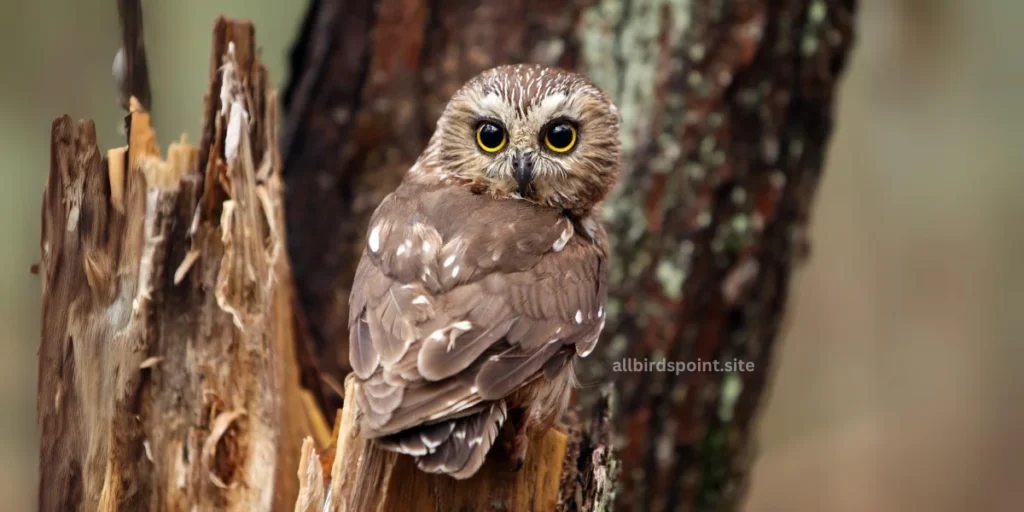
Appearance of the Northern Saw-whet Owl
The Northern Saw-whet Owl is one of the smallest owls in North America, often described as “adorable” due to its tiny size and round face. It has a brown body with white streaks on the head and back, and its large, bright yellow eyes make it stand out. The owl gets its name from the sound of its call, which resembles the sharpening of a saw on a whetting stone.
Habitat and Nesting
Northern Saw-whet Owls prefer dense coniferous forests or mixed woodlands for roosting and nesting. These owls are cavity nesters, often using old woodpecker holes or nest boxes. They usually remain hidden during the day, perched in dense cover, making them difficult to spot. The female lays 4 to 7 eggs, which are incubated for about 27 to 30 days.
Hunting and Diet
The Northern Saw-whet Owl is a nocturnal hunter, preying primarily on small mammals like mice, voles, and shrews. These owls hunt by waiting on a low perch and swooping down on their prey. Despite their small size, they are fierce hunters and rely on their excellent hearing and vision to locate prey in the dark.
Best Places to Spot Northern Saw-whet Owls in South Carolina
Although uncommon, the Northern Saw-whet Owl can be found in South Carolina, especially during migration. The best time to spot them is in winter, and some good places to look include Congaree National Park and areas with dense woodlands and forest cover. These owls are shy and secretive, so they are not easy to find.
Behavior and Calls
The call of the Northern Saw-whet Owl is a repetitive toot-toot-toot sound, similar to the sound of a saw being sharpened. They are quiet during most of the year but become more vocal during the breeding season. These owls are generally solitary and well-camouflaged, making them challenging to observe in the wild.
Burrowing Owl: The Owl that Lives Underground
- Wingspan: 55 cm
- Length: 19 – 25 cm
- Mass: 150 grams
- Maximum Lifespan: 9 years
- Scientific Name: Athene cunicularia
- Coloration: Brown with white spots, long legs, and bright yellow eyes

Appearance of the Burrowing Owl
The Burrowing Owl is a small, long-legged owl known for its unique behavior of living in burrows underground, unlike most other owls. It has brown feathers with white spots on its upper body and pale underparts. Its bright yellow eyes and lack of ear tufts make it easy to identify. This owl has a smaller body compared to other species, but its long legs help it stand taller and run on the ground.
Habitat and Nesting
As its name suggests, the Burrowing Owl lives in underground burrows. These burrows are often dug by other animals, such as prairie dogs or ground squirrels, which the owl then uses as its home. Burrowing Owls prefer open areas such as grasslands, deserts, and agricultural fields where they can easily spot prey and predators.
They nest in these burrows and lay 6 to 12 eggs, which are incubated for about 28 to 30 days. Unlike many owls, Burrowing Owls are active during the day (diurnal) as well as at night, especially around dawn and dusk.
Hunting and Diet
Burrowing Owls are skilled hunters that feed on a variety of prey. Their diet includes insects, such as grasshoppers and beetles, as well as small mammals, like mice and voles. They are opportunistic feeders, meaning they will eat whatever is available, including small birds, reptiles, and amphibians. These owls often hunt by running on the ground to catch their prey, but they can also fly to snatch insects out of the air.
Best Places to Spot Burrowing Owls in South Carolina
The Burrowing Owl is not commonly found in South Carolina, as it is more frequently seen in western and southern parts of North America. However, on rare occasions, they may wander into the state. Open fields, farmlands, and areas with plenty of ground-dwelling animals are the most likely places to spot a Burrowing Owl if one happens to be passing through.
Behavior and Calls
Burrowing Owls are unique not only for their underground homes but also for their behaviors. They are more active during the day than most other owl species. Their calls are often described as a cooing sound, but they can also make hissing or rattling sounds to scare away predators. They are known for their alert posture, often standing at the entrance of their burrow to keep watch.
Great Gray Owl: The Silent Giant of the Northern Forests
- Wingspan: 137 – 152 cm
- Length: 61 – 84 cm
- Mass: 790 – 1450 grams
- Maximum Lifespan: 12 years
- Scientific Name: Strix nebulosa
- Coloration: Gray body with dense streaking, large round face, and bright yellow eyes
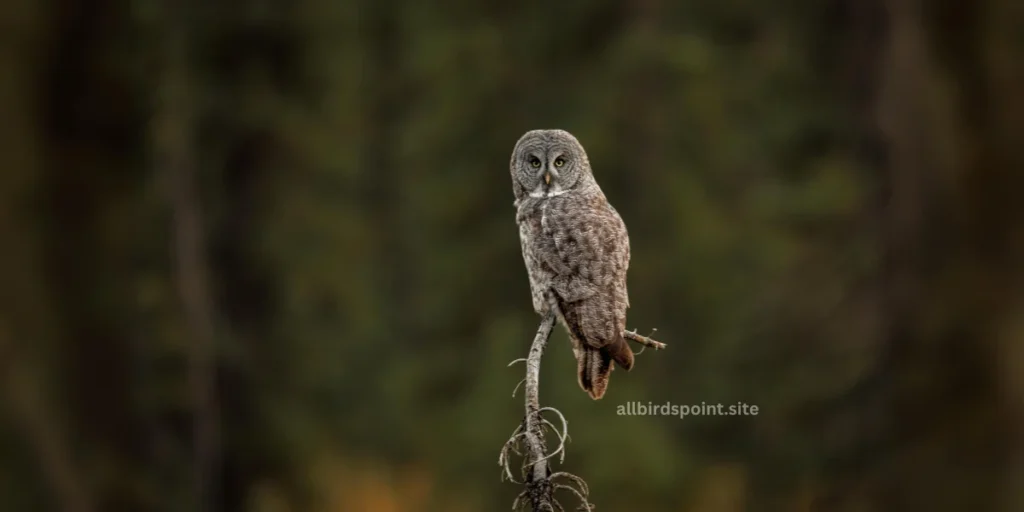
Appearance of the Great Gray Owl
The Great Gray Owl is one of the largest owls in North America, but despite its size, it is relatively lightweight due to its fluffy feathers. It has a striking appearance with a gray body covered in fine streaks, a large, round head with no ear tufts, and bright yellow eyes. The owl’s face is particularly broad, and its large facial disc helps it detect sounds while hunting.
Habitat and Nesting
Great Gray Owls prefer dense coniferous forests and open meadows where they can easily hunt. They are more commonly found in northern regions, especially across Canada and Alaska, but sometimes wander into the northern United States. These owls do not build their own nests but instead use old nests built by other birds, such as hawks or ravens, or nest in broken tree stumps.
The female typically lays 2 to 5 eggs, and the incubation period lasts around 28 to 30 days. Unlike other owls, they can survive in cold climates due to their thick plumage.
Hunting and Diet
The Great Gray Owl is a formidable hunter, relying on its exceptional hearing to detect prey beneath the snow or vegetation. Its primary diet consists of small mammals, particularly voles, but it also hunts mice, squirrels, and occasionally small birds. The owl is known for its ability to dive through snow to capture hidden prey, using its sharp talons to grab it.
Best Places to Spot Great Gray Owls
Great Gray Owls are rare in South Carolina but can occasionally be seen in the northern U.S. during irruptive years when food is scarce in their typical range. To spot them, birdwatchers should visit open forests or meadows, where they hunt during dawn and dusk.
Behavior and Calls
Great Gray Owls are known for their calm and quiet demeanor. Their vocalizations include a deep “whooo” sound, which can carry long distances, especially in open landscapes. They are generally solitary birds and tend to be less vocal outside of the breeding season. Despite their size, they are not aggressive and are more likely to retreat than confront potential threats.
Conclusion
South Carolina is a diverse habitat for several fascinating owl species, from the small and adaptable Eastern Screech Owl to the majestic winter visitor, the Snowy Owl. Each species plays an important role in maintaining the balance of ecosystems, controlling populations of small mammals and insects. The state’s variety of forests, grasslands, and wetlands offer ideal environments for these owls to thrive. Whether you’re an avid birdwatcher or a nature lover, the opportunity to observe these nocturnal creatures in their natural habitats enriches any outdoor experience in South Carolina. Understanding their behaviors, calls, and habitats not only enhances our appreciation of these mysterious birds but also highlights the importance of conservation efforts to protect their environments.
FAQs
1. What types of owls can be found in South Carolina?
South Carolina is home to several owl species, including the Eastern Screech Owl, Barred Owl, Barn Owl, Great Horned Owl, and rarer winter visitors like the Snowy Owl and Short-eared Owl.
2. Where is the best place to spot owls in South Carolina?
Some of the best places to spot owls include Congaree National Park, Francis Marion National Forest, and Santee National Wildlife Refuge. These areas provide the forested habitats and open spaces preferred by many owl species.
3. Are owls active during the day or night?
Most owls, such as the Great Horned Owl and Barred Owl, are nocturnal, meaning they are active at night. However, some species, like the Short-eared Owl, are also active during the day, especially at dawn and dusk.
4. What do owls in South Carolina eat?
Owls in South Carolina primarily hunt small mammals like mice, squirrels, and rabbits. Some also feed on birds, insects, and reptiles. The Barn Owl, for instance, is known for its diet of small rodents, while the Great Horned Owl can take down larger prey, including other birds of prey.
5. How do owls hunt?
Owls use their excellent night vision and silent flight to sneak up on prey. They also have exceptional hearing, which helps them detect movement even in complete darkness.
